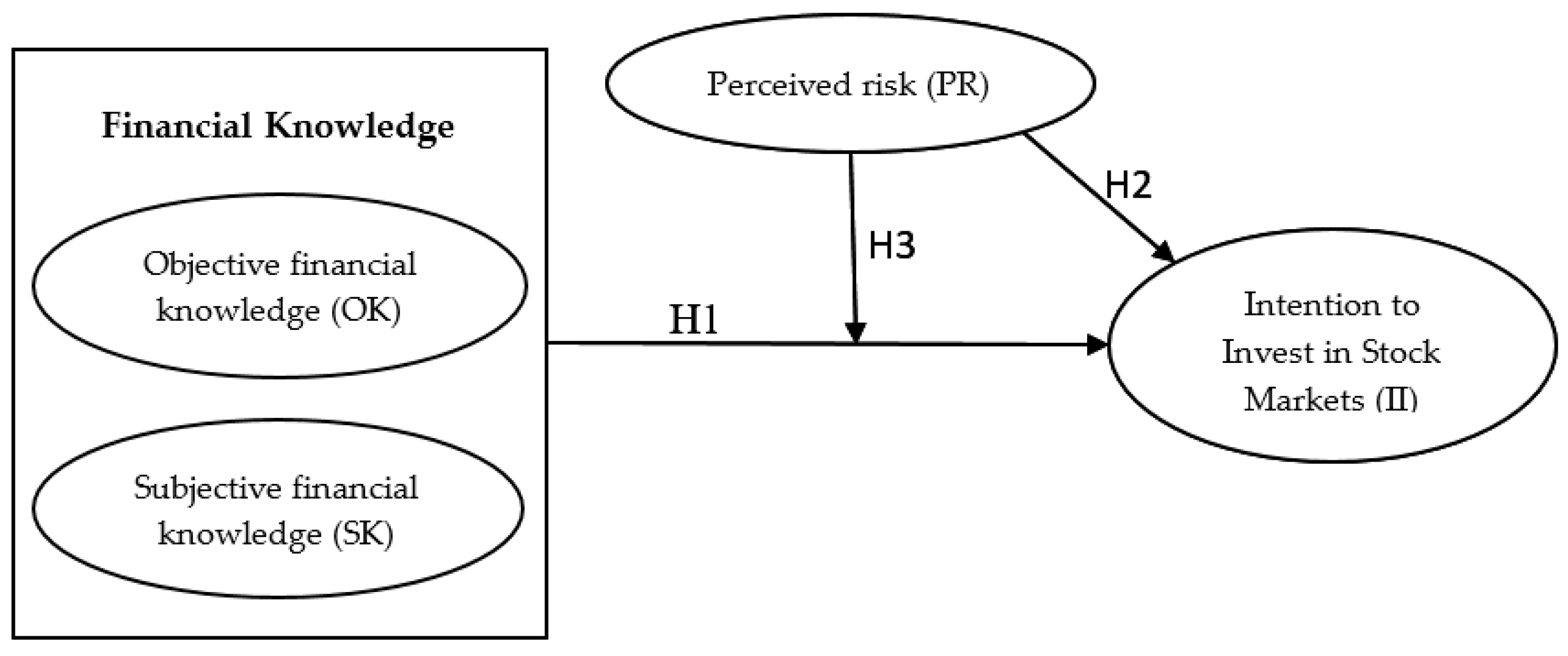2.1. Financial Knowledge
Financial knowledge refers to an individual’s understanding of important concepts related to finance (
Robb and Sharpe 2009). It has two dimensions: namely, subjective knowledge and objective knowledge. Subjective knowledge refers to the extent of each person’s self-rated level of knowledge of financial matters. On the other hand, objective knowledge refers to real financial knowledge calculated by the person’s summary score of answers to knowledge items about financial concepts such as inflation, interest rate, stock market, savings, credit, and insurance (
Khan et al. 2017;
Lee et al. 2019).
The findings from previous studies indicate that financial knowledge plays a fundamental role in facilitating investment decisions. By surveying 1006 participants,
Fedorova et al. (
2015) examined financial knowledge’s impact on the investors’ stock market decisions. This study’s findings showed that investors, who are knowledgeable about the financial literature, participate proactively in the stock market. In a different study,
Sivaramakrishnan et al. (
2017) examined financial knowledge’s impact on the investors’ stock market decision-making processes. The research employed the theory of planned behavior to explain the investors’ participation in India’s Stock Market. Planned behavior theory asserts that the investors’ financial literacy determines how they control their behavior in the stock market. This study’s findings showed that both objective and subjective financial knowledge had positive effects on the intention to invest in a stock market, while the investors’ behaviors were influenced primarily by objective knowledge. This study’s findings also showed that financial wellbeing had a positive influence on investor behaviors and their investment decisions. Therefore, while financial knowledge is necessary for investors, it does not lead an investor to make optimal investment decisions because only the objective financial literacy affects the actual behavior. However, both subjective and objective knowledge affect the intention to invest.
Furthermore,
Khan et al.’s (
2017) findings show the necessity of examining the relationship between an individual’s subjective and objective knowledge (knowledge gap), since it helps in understanding their financial behaviors. An overestimation of an individual’s financial knowledge can lead them to make risky investment decisions. Notably, older individuals with lower education have an overestimated perception of their financial knowledge and this leads to poorly informed investment decisions. Therefore, investors can be financially vulnerable and have an incorrect perception of the adequacy of their actual financial knowledge. Reliance on insufficient knowledge leads to making poorly informed decisions that are ultimately suboptimal.
The investors’ decision making is influenced by several factors. These include corporate data, repayment, risk and financial knowledge (
Lubis et al. 2015). Similarly,
Hamza and Arif’s (
2019) findings showed that financial knowledge is an important factor in the investment decision. Notably, this study’s findings showed that financial knowledge and agreeableness had significant positive impacts on investment decisions along with significant negative impacts on openness to investment and neuroticism. Additionally, extraversion and conscientiousness had insignificant impacts on investment decisions. At the same time, when making investment decisions, neuroticism and openness play critical roles in mediating the role of financial knowledge. Therefore, financial literature alone cannot be relied on in investor decisions since the personality traits mediate its role in influencing the decision-making process. Notably, an investor’s personality trait determines the attitude toward the potential investment decisions.
Nowadays, numerous organizations are developing financial literacy programs to equip investors with financial knowledge and to provide counseling based on the investor’s attitude toward perceived risks (
Hamza and Arif 2019). According to
Gizem Korkmaz et al. (
n.d.), there is limited evidence to show that investors have enough knowledge to facilitate their decision-making processes. Despite the vast sources of financial knowledge and increased educational programs, many individuals still make suboptimal financial decisions that negatively affect their economic activities (
Agarwal and Mazumder 2013). Therefore,
Gizem Korkmaz et al. (
n.d.) examined the impact of risk behavior, risk propensity, and risk preference on financial decision-making. This study’s findings showed that there is an inconsistency between risk behavior and risk preferences. However, financial knowledge is prudent since it helps to overcome the inconsistencies for risk-seeking individuals and worsens the level of inconsistencies for risk-averse individuals. Financial knowledge encourages individuals to indulge in risky behaviors while little knowledge reduces the chances of engaging in risky behaviors. Therefore, investment decisions, which lean toward risky investment decisions, suggest that investors have significant financial knowledge while risk-averse investors have minimal financial knowledge.
2.2. Perceived Risks
Perceived risks affect the investor’s ability to use their financial knowledge to make an optimal decision. Risk perception describes how an individual interprets and develops a picture from the received information. This is normally different from reality, thoughts, and estimates (
Ainia and Lutfi 2019). Risk perception is part of cognitive bias and, in uncertain situations, influences human behavior and decision -making. Similarly,
Trang and Tho’s (
2017) findings showed that perceived risks have direct positive impacts on performance and the intention to invest and, through the performance of the investments, an indirect impact on the intention to invest. According to
Ainia and Lutfi (
2019), the greater the individual’s risk perception, the lower the chance that they will make an investment, and the vice versa is true. Therefore, a high-risk attitude has negative impacts since these reduce the opportunities that an investor will allocate more funds to highly risky assets.
In contrast,
Trang and Tho’s (
2017) findings showed that the greater the perceived risk, the more the investors are satisfied with their investment decisions. Similarly, the high obtained returns increase the intention to invest the next time. According to
Trang and Tho (
2017), investors are recommended to draw attention to stocks that are labeled ‘controlled’, ‘warned’, and ‘halted trading’. Therefore, while financial knowledge is important in determining investment decisions, the perceived risks, associated with the stock, can override financial knowledge and influence their investment decisions. Additionally, the perceived risks can either influence an investor to make highly risky decisions or refrain from making risky investment decisions.
Entrepreneurs are risk-takers and set their investment goals by taking reasonable risks. According to
De Bortoli et al. (
2019), investors make the ideal, perfectly rational, and self-interested people and choose the best available option to maximize their utility in an efficient market. Unfortunately, the individual investor’s personal character traits are a notable factor that affect their investment decisions. Therefore, the agent’s behavior is not perfectly rational since cognitive and emotional errors influence their investment decisions. According to
De Bortoli et al. (
2019), investors, who have greater risk tolerance and a high degree of openness to experience and violate prospect theory, are more likely to make high risk investment decisions. More specifically, the investor profile analysis (IPA) in relation to the personality openness to experience leads an investor to make high risk investment decisions.
Turning to prospect theory, an investor is less likely to make a risky investment decision when they violate provisions in the utility theory. Similarly,
Sadiq and Amna (
2019) say that investors can only make rational decisions with the availability of perfect information. However, unfortunately, investors have limited financial knowledge and this leads them to miss opportunities and make satisfactory investment decisions. Additionally, cognitive and psychological factors inhibit an investor’s ability to make a rational investment decision (
Sadiq and Amna 2019).
Therefore, while investors aim to decide which will promote the attainment of maximum revenue, their abilities to make an optimal decision when risks are involved are affected by their personalities that result from their psychological and cognitive makeup.
From their investigation of the impact of cultural differences in investors’ decisions,
Lobao and Maio’s (
2019) findings showed that culture influenced herding behaviors and, consequently, the investors’ financial decision. Similarly,
Chang and Lin (
2015) investigated the factors that determined investor decision-making in an international stock market and, more particularly, the impact of national culture in influencing the investors’ decisions in the global market. Their findings showed that herding behavior among investors happens in less sophisticated and Confucian equity markets. Notably, national culture has the most influence on herding behavior.
Furthermore,
Chang and Lin’s (
2015) findings showed that the national culture’s influence on the investors’ herding behavior resulted in their making unfortunate investment decisions. Additionally, perceived risks and, in turn, their impact affects investors’ decisions. According to
Ferreira (
2018), different people’s risk attitudes and perceptions of risks are dependent on their financial models used in portraying perceived risks. The objective and subjective risk propensity explain the investment behaviors. However, cultural factors, institutions, and geographical location significantly influence the development of risk preferences in investments. Ultimately, national culture affects how investors perceive risks in the international market. The application of national culture compromises the individuals’ needs to learn how the stock market in foreign countries operates and, hence, the high levels of investors’ behavioral pitfalls in the international market.
2.3. Intention to Invest
The behavioral intention to invest refers to the investors’ attitudes to making decisions due to the many factors that motivate them to act on their intentions and perceptions to make investment decisions.
Ali (
2011) studied the relationships between the individual investors’ perceived corporate financial performance and their intentions to invest and the mediating impact of corporations’ images on such relationships. The researcher emphasizes that investors are customers with knowledge requirements including the need to properly determine the risks and returns of businesses. The study’s findings showed that investors formed their intentions to invest when they evaluated the businesses’ financial positions. Thereafter, as they attempt to explain their investment decisions in the company’s stocks, their emotional expectations of such assessments come into effect. This study’s findings showed that, when the investors assessed a firm, their attitudes acted as a mediator before they decided to invest in a company’s stocks.
This study’s findings also showed that companies’ attractive marketing strategies can have a huge influence on investors’ emotions. Consequently, investors’ attitudes toward the companies’ brands play a significant role, besides the cognitive assessment of companies in anticipating their final actions in terms of investing in these companies’ stocks.
Trang and Tho (
2017) established new perceived risk measurement scales in relation to the Vietnam Stock Market. Their study investigated the impact of perceived risk on investment performance and used these scales to measure the investors’ investment intentions. This study’s findings show that the greater the investors perceive risks in making an investment, the greater the satisfaction of their investment decisions, or the more they will invest in the stock.
Perceived risks in the investing environment are described as unexpected or unpleasant results from the investor’s action, in addition to establishing a new scale to measure the degree to which investors perceive the risk of investing in forms of stock trading on the stock market.
Trang and Tho (
2017) also measured the degree to which the perceived risks influenced investor satisfaction and their intentions on investment performance compared to their expectations and investment decisions. This study’s findings showed that perceived risk had a significant positive effect on investment efficiency and on the investors’ investment intentions. On the other hand, perceived risk had an adverse impact on the investors’ intentions to invest through investment performance. This study’s findings showed a positive relationship between the investors’ perceived risks and the satisfaction of their investment decisions to invest in the stock.












